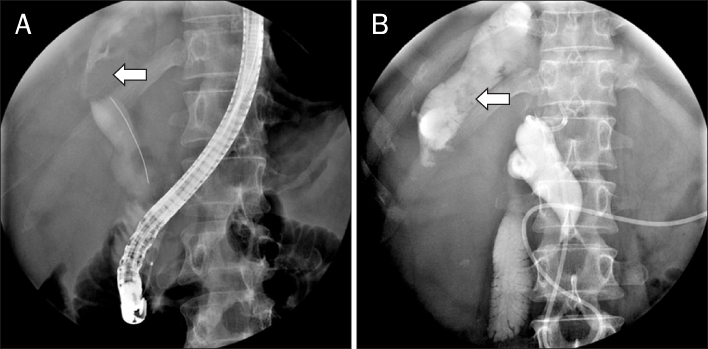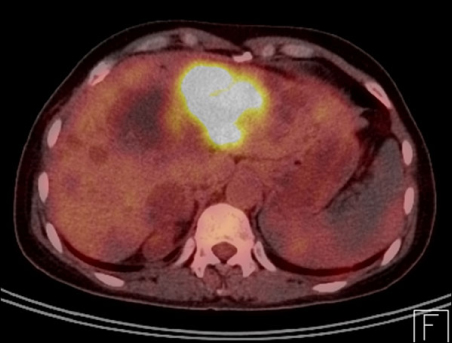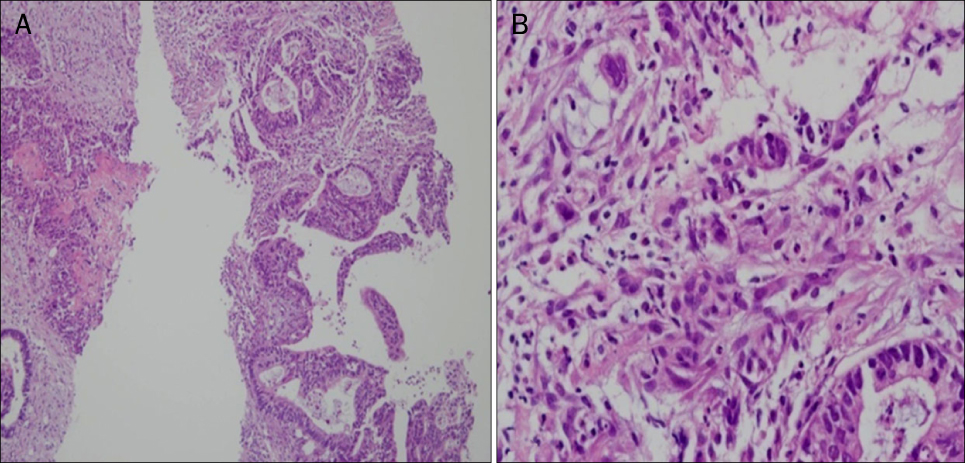Korean J Gastroenterol.
2012 Aug;60(2):123-127. 10.4166/kjg.2012.60.2.123.
A Case of Intrahepatic Cholangiocarcinoma Associated with Type IV Choledochal Cyst
- Affiliations
-
- 1Department of Internal Medicine, Pusan National University School of Medicine, Yangsan, Korea. mdkhwook@gmail.com
- KMID: 1387342
- DOI: http://doi.org/10.4166/kjg.2012.60.2.123
Abstract
- Anomalous union of the pancreaticobiliary duct (AUPBD) is a congenital anomaly that is defined as a junction of the bile duct and pancreatic duct outside the duodenal wall. This anomaly results in a loss of normal sphincteric mechanisms at the pancreaticobiliary junction. As a result, regurgitation of pancreatic juice into the biliary system develops and causes choledochal cysts, choledocholithiasis, cholangitis, pancreatitis and malignancy of the biliary tract. Gallbladder cancer or common bile duct cancer associated with AUPBD and choledochal cysts have been frequently reported. But, intrahepatic cholangiocarcinoma associated with this condition has been only rarely reported. Here, we report a case of intrahepatic cholangiocarcinoma associated with AUPBD and choledochal cyst.
Keyword
MeSH Terms
-
Adult
Bile Duct Neoplasms/*diagnosis/etiology/pathology
*Bile Ducts, Intrahepatic
Cholangiocarcinoma/*diagnosis/etiology/pathology
Cholangiopancreatography, Endoscopic Retrograde
Cholangiopancreatography, Magnetic Resonance
Choledochal Cyst/complications/*diagnosis
Female
Humans
Positron-Emission Tomography and Computed Tomography
Tomography, X-Ray Computed
Figure
Cited by 1 articles
-
Cholangiocarcinoma in choledochal cyst after cystoenterostomy: how a mistreated choledochal cyst can progress to malignancy
HyungJoo Baik, Yo-Han Park, Sang Hyuk Seo, Min Sung An, Kwang Hee Kim, Ki Beom Bae, Chang Soo Choi, Sang Hoon Oh, Young Kil Choi
Ann Hepatobiliary Pancreat Surg. 2016;20(4):201-203. doi: 10.14701/ahbps.2016.20.4.201.
Reference
-
1. Song HK, Kim MH, Myung SJ, et al. Choledochal cyst associated the with anomalous union of pancreaticobiliary duct (AUPBD) has a more grave clinical course than choledochal cyst alone. Korean J Intern Med. 1999. 14:1–8.2. Matsumoto Y, Fujii H, Itakura J, Matsuda M, Nobukawa B, Suda K. Recent advances in pancreaticobiliary maljunction. J Hepatobiliary Pancreat Surg. 2002. 9:45–54.3. Shimamura K, Kurosaki I, Sato D, et al. Intrahepatic cholangiocarcinoma arising 34 years after excision of a type IV-A congenital choledochal cyst: report of a case. Surg Today. 2009. 39:247–251.4. Goto N, Yasuda I, Uematsu T, et al. Intrahepatic cholangiocarcinoma arising 10 years after the excision of congenital extrahepatic biliary dilation. J Gastroenterol. 2001. 36:856–862.5. Nomura T, Shirai Y, Wakai T, Yokoyama N, Sakata J, Hatakeyama K. Narrow portion of the terminal choledochus is a cause of upstream biliary dilatation in patients with anomalous union of the pancreatic and biliary ducts. World J Gastroenterol. 2005. 11:6503–6507.6. Misra SP, Dwivedi M. Pancreaticobiliary ductal union. Gut. 1990. 31:1144–1149.7. Kamisawa T, Takuma K, Itokawa F, Itoi T. Endoscopic diagnosis of pancreaticobiliary maljunction. World J Gastrointest Endosc. 2011. 3:1–5.8. Min YI, Lee SK, Kim MH, et al. Choledochal cyst and anomalous union of pancreaticobiliary duct in the adult. Korean J Gastrointest Endosc. 1996. 16:41–48.9. Kimura K, Ohto M, Ono T, et al. Congenital cystic dilatation of the common bile duct: relationship to anomalous pancreaticobiliary ductal union. AJR Am J Roentgenol. 1977. 128:571–577.10. Babbitt DP, Starshak RJ, Clemett AR. Choledochal cyst: a concept of etiology. Am J Roentgenol Radium Ther Nucl Med. 1973. 119:57–62.11. Todani T, Watanabe Y, Narusue M, Tabuchi K, Okajima K. Congenital bile duct cysts: Classification, operative procedures, and review of thirty-seven cases including cancer arising from choledochal cyst. Am J Surg. 1977. 134:263–269.12. Jesudason SR, Govil S, Mathai V, Kuruvilla R, Muthusami JC. Choledochal cysts in adults. Ann R Coll Surg Engl. 1997. 79:410–413.13. Lee HK, Park SJ, Yi BH, Lee AL, Moon JH, Chang YW. Imaging features of adult choledochal cysts: a pictorial review. Korean J Radiol. 2009. 10:71–80.14. Bakka A, Bergan A, Søreide O. Bile duct cysts in adults. Pitfalls in diagnosis and management. Scand J Gastroenterol. 1991. 26:197–206.15. Sandoh N, Shirai Y, Hatakeyama K. Incidence of anomalous union of the pancreaticobiliary ductal system in biliary cancer. Hepatogastroenterology. 1997. 44:1580–1583.16. Tsuchida A, Itoi T. Carcinogenesis and chemoprevention of biliary tract cancer in pancreaticobiliary maljunction. World J Gastrointest Oncol. 2010. 2:130–135.17. Matsubara T, Sakurai Y, Zhi LZ, Miura H, Ochiai M, Funabiki T. K-ras and p53 gene mutations in noncancerous biliary lesions of patients with pancreaticobiliary maljunction. J Hepatobiliary Pancreat Surg. 2002. 9:312–321.18. Hasumi A, Matsui H, Sugioka A, et al. Precancerous conditions of biliary tract cancer in patients with pancreaticobiliary maljunction: reappraisal of nationwide survey in Japan. J Hepatobiliary Pancreat Surg. 2000. 7:551–555.
- Full Text Links
- Actions
-
Cited
- CITED
-
- Close
- Share
- Similar articles
-
- Type IV-A Choledochal Cyst with Intrahepatic Bile Duct Stricture
- A Choledochal Cyst Combined with a Hilar Cholangiocarcinoma
- Development of intrahepatic cholangiocarcinoma at the remnant intrahepatic cyst portion 10 years after resection of type IV choledochal cyst
- Squamous Cell Carcinoma of the Liver after Choledochal Cystectomy
- A Case of Cholangiocarcinoma Arising from Type I Choledochal Cyst in a 13-year-old Girl






